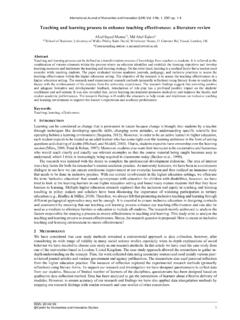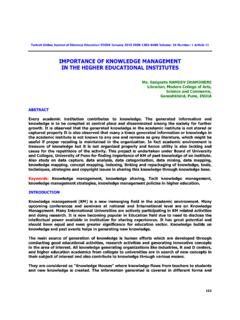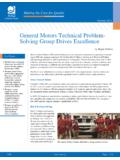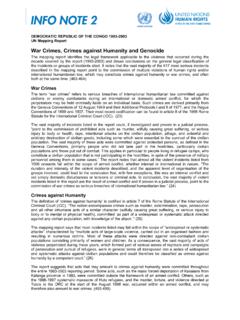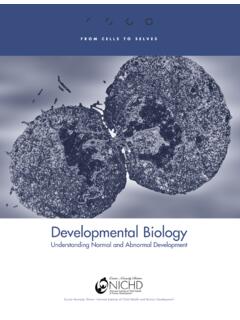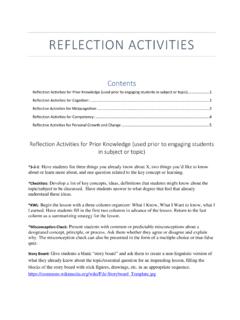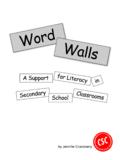Transcription of STRATEGY: Thinking Maps - Tools for Learning
1 National Urban Alliance for Effective Education Thinking Maps 1 STRATEGY: Thinking Maps - Tools for Learning The Thinking Maps are a common visual language based on FUNDAMENTAL COGNITIVE PROCESS that is transferable across disciplines and among grade levels. Administrators, parents, teachers and students use this toolkit to facilitate content Learning , reading comprehension, decision-making, problem-solving, written and verbal communication and knowledge creation. Used together as a language, whole schools apply these graphically and cognitively consistent, flexible Tools to support students continuous cognitive development through their entire schooling career and to promote the development of a collaborative professional Learning community.
2 SKILLS ADDRESSED: 8 FUNDAMENTAL COGNITIVE SKILLS Each Thinking skill is paired with a graphic primitive map. Page 1-9 manual DEFINING IN CONTEXT DESCRIBING COMPARING AND CONTRASTING CLASSIFYING SEQUENCING CAUSE AND EFFECT REASONING PART-WHOLE RELATIONSHIPS SEEING ANALOGIES STEPS INVOLVED IN BUILDING Thinking FLUENCY 1. Introducing the maps: Teachers model one map/ week to the students introducing the cognitive vocabulary attached to that particular graphic. Students immediately practice the map and skill. 2. Shared Responsibility: After the introductory period, teachers should continue to emphasis the Thinking vocabulary that occurs in content to help students identify the Thinking process.
3 Teachers should coach students to find key words in text and ask, What kind of Thinking ? Which map(s) could we use? How can we think about this? Students can start selected the appropriate Thinking depending on the task? 3. Student Ownership: Students build fluency with their Thinking by selecting appropriate maps based on the Thinking skills they are performing. 4. Student Fluency: Students use multiple-maps to process information. Strategy source: see Thinking Maps: Tools for Learning Manual by David Hyerle National Urban Alliance for Effective Education Thinking Maps 2 STRATEGY: Thinking Map - The Frame SKILLS ADDRESSED COGNITIVE SKILL: CONTEXT AND PERSPECTIVE Answering the questions: What prior knowledge, experiences, emotions, customs, beliefs, values and cultural influences are shaping my understanding of this thing, idea, topic or concept?
4 From what perspective am I viewing and understanding this thing? How do I know what I know? Where did I get my ideas? What other perspectives exist? Frame of reference and point of view identifying sources, influences, motivations establishing and recognizing personal bias, lenses, angles or filters PREREQUISITES Graphic and purpose must be familiar to students Students understand terms such as: perspective, source, influences, etc. Students have practice with reflection and Thinking beyond the surface. STEPS INVOLVED 1. Teachers or students can place a Frame of Reference around any map at any time during instruction. 2. Students should examine the information that already exists on the map and ask themselves, Why do I think about it in that way?
5 What is influencing or shaping my understanding? Or ask any of the other frame questions mentioned above. 3. Students should record their ideas in the Frame of Reference around the outside of the map. Students could: - prioritize, assess, question or categorize the influences - Try to identify which perspectives or points of view are missing - Identify which filters seem to dominate: emotional, spiritual, familial, political 4. Students should think how someone else might perceive the same topic. Look at the topic from another point of view with a new frame of reference. RELATED Learning PRINCIPLES Self discovery and connection to support meaning making. Visually representing thoughts in order to manipulate, disaggregate, and construct articulate composition.
6 Modeling and scaffolding reflection and metacognition. APPLICATION Examining multiple perspectives from history, literature, political issues/stances Evaluating and questioning sources of information Pre-Writing tool for persuasive essays, diaries, journals, point of view writings Strategy source: see Thinking Maps: Tools for Learning Manual by David Hyerle National Urban Alliance for Effective Education Thinking Maps 3 STRATEGY: Thinking Map - Bubble Map SKILLS ADDRESSED COGNITIVE SKILL: DESCRIBING Answering the questions: What are its attributes, qualities, traits, characteristics and properties? How would you describe this thing? What does it look like, feel like, etc?
7 Describing using adjectives: sensory, emotional /aesthetic, and logical qualities Vocabulary development and enrichment Distinguishing between fact and opinion Improving observation skills in science and vivid language use in writing PREREQUISITES Graphic and purpose must be familiar to students Students understand senses and words related to emotions STEPS INVOLVED 1. Teacher or students decide on an object, event, thing to be qualified and place that word in the center bubble of the Bubble Map. 2. Students individually, in partners, groups or as a whole class generate words to describe that thing by using sensory words (rough, striped), emotional words (dangerous, threatening) and logical (heavy, large).
8 Those words are added one word/bubble as they are generated. 3. Teacher might have to ask follow-up questions like, What does it look like, feel like, etc to help students or use a concrete object to describe to support the use and understanding of adjectives or adjective phrases. 4. Depending on the purpose/direction of the lesson and on the information in the Bubble Map, students could: - write a sentence using several adjective phrases that describes the topic - categorize the qualities on a Tree Map with color coding - frame the Bubble Map to provide evidence to support the adjectives stated - sort qualities into fact or opinion 5. Students should revise the Bubble Map as they learn new information and refer to it when composing writing or giving oral presentations.
9 They could use different colors each time they update the information to see what they had learned over time. RELATED Learning PRINCIPLES Connotation and denotation of words. Providing evidence for opinions. Visually representing thoughts in order to manipulate, disaggregate, and construct articulate composition. Modeling and scaffolding information processing and metacognition. APPLICATION Developing synonyms and adjective formation Inference tool Character/Biographical Analysis Notetaking for science observation Pre and Post assessment tool for before and after a Learning episode Pre-writing tool for descriptive writing or character sketch before sequencing (Flow Map) Strategy source: see Thinking Maps: Tools for Learning Manual by David Hyerle National Urban Alliance for Effective Education Thinking Maps 4 STRATEGY: Thinking Map - Double-Bubble Map SKILLS ADDRESSED COGNITIVE SKILL: COMPARING AND CONTRASTING Answering the questions: How are these things, ideas, etc similar and different?
10 How are they alike? What are the corresponding qualities to compare and contrast? Are they more alike or different? What are the most important qualities that are similar and different? Vocabulary development and enrichment Distinguishing between fact and opinion PREREQUISITES Graphic and purpose must be familiar to students Students understand cognitive terms similar/different and compare/contrast STEPS INVOLVED 1. Teachers or students decide on two things to compare and contrast, and write those two words in bubbles somewhat spaced and centered on the page. 2. Students individually, in partners, groups or as a whole class record the similarities in bubbles located between the two things being compared.
